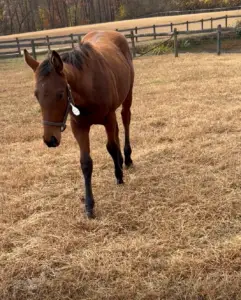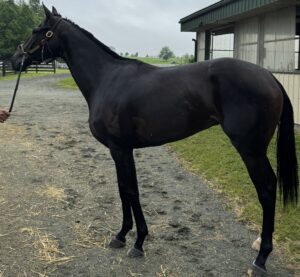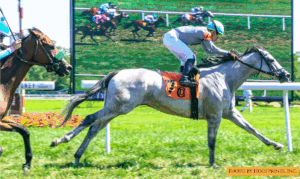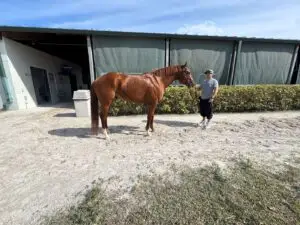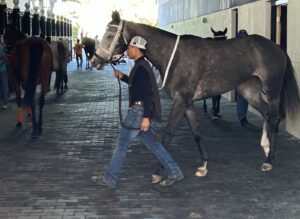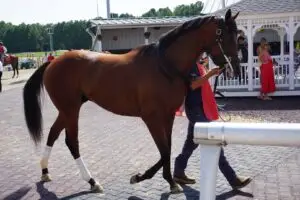Owning a racehorse isn’t just for deep-pocketed investors anymore.
Horse racing syndicates have kicked down the doors, making ownership a reality for more people than ever before.
Rather than one person carrying the full weight of expenses, a horse racing syndicate spreads the cost across a group of owners.
It’s racehorse ownership without the financial headache—a shared investment, a shared thrill, and a shared shot at the winner’s circle.
But don’t mistake this for a passive investment.
Being part of a horse racing syndicate means more than just buying a stake in a horse—you’re part of the team. Owners get inside access, regular updates, and the chance to experience the highs (and sometimes lows) of thoroughbred racing firsthand.
For those who always wanted to be more than just a spectator, a horse racing syndicate is the ticket in.
The thrill, the competition, the camaraderie—it’s all here.
What Is a Horse Racing Syndicate?
A horse racing syndicate is a group of investors who collectively own a racehorse, sharing the costs, responsibilities, and potential rewards of ownership.
Instead of one person covering all the expenses, the financial burden is split among multiple members, making racehorse ownership more accessible.
Most horse racing syndicates are managed by an experienced syndicate operator, who oversees the horse’s training, race selection, and day-to-day management.
Members get regular updates, race-day privileges, and a share of any prize money the horse earns—without having to handle the logistics themselves.
For those looking to experience the thrill of ownership without the full commitment of sole ownership, joining a horse racing syndicate offers an affordable and exciting entry point into the sport.
How Horse Racing Syndicates Work
Owning a racehorse isn’t just about writing a check and watching from the stands. In a horse racing syndicate, ownership is structured, managed, and designed to give members a stake in the action without the full burden of sole ownership.
From the way funds are pooled to the level of involvement members have, horse racing syndication operates under a clear set of rules—some syndicates are purely investment-driven, while others offer hands-on experiences like stable visits and race-day access.
Understanding Horse Racing Syndication
At its core, horse racing syndication is about pooling resources—multiple investors contribute to the cost of buying, training, and racing a horse. Instead of a single owner taking on the full financial responsibility, a horse racing syndicate divides expenses among its members, making ownership more affordable and accessible.
Each syndicate operates under a structured agreement, outlining ownership percentages, financial commitments, and decision-making processes. Some are tightly managed by a syndicate operator, while others allow members to have more direct input on racing plans, trainer selection, and long-term strategies.
There are two primary types of racehorse ownership groups:
Public Horse Racing Syndicates
A public horse racing syndicate is the most common and accessible way to get into ownership. Open to anyone willing to buy in, these syndicates are often promoted through racing clubs, online platforms, and industry professionals who specialize in syndication.
One of the biggest advantages of public syndicates is their structured approach.
The syndicate manager handles everything, from selecting the horse to training decisions, race entries, and even handling the logistics of ownership paperwork. This makes public syndicates an ideal choice for first-time owners who want to experience the thrill of ownership without having to manage the day-to-day responsibilities.
The financial commitment is also far lower than traditional ownership. Many public syndicates allow investors to buy into a racehorse for a few hundred or thousand dollars, making it a low-risk way to enter the industry.
Investors typically receive regular updates on their horse’s training and race schedule, and some syndicates offer perks like stable visits, paddock access, and race-day hospitality.
That said, public syndicates come with less control over decision-making. Since ownership is divided among many members, the managing syndicate operator makes all major choices regarding the horse’s career. Members are essentially along for the ride, enjoying the benefits but without direct influence over the horse’s training or race selection.
For those looking for a hassle-free and affordable entry point into racehorse ownership, public horse racing syndicates offer a fun, exciting, and low-commitment way to be part of the sport.
Private Horse Racing Syndicates
A private horse racing syndicate is a more exclusive approach to shared ownership, typically formed by smaller groups of investors.
Unlike public syndicates, private ones aren’t advertised to the general public and often require a personal invitation or direct involvement with industry professionals.
These groups might be friends pooling resources, business partners looking for a racing investment, or high-net-worth individuals aiming to compete at the top levels of the sport.
Because private syndicates have fewer members, each owner typically holds a larger percentage of the horse, which means higher potential earnings—but also a greater share of the financial responsibility.
Private syndicates generally provide more control than public ones. Members often have a say in major decisions, such as choosing the trainer, selecting race entries, and even determining whether to sell or retire the horse. Some private syndicates also target elite bloodstock, investing in well-bred thoroughbreds with the potential for long-term success on the track and in the breeding shed.
However, the higher buy-in costs and increased financial risks make private syndicates better suited for experienced owners or serious investors.
Unlike public syndicates, where the focus is often on making ownership accessible to casual fans, private syndicates cater to those who want a deeper level of involvement in the sport.
For those looking to combine strategic decision-making with the thrill of ownership, private horse racing syndicates offer a more personalized and high-stakes experience.
The Syndicate Ownership Experience
Joining a horse racing syndicate means more than just owning a percentage of a horse—it’s about being part of the sport in a way that casual fans never get to experience.
Depending on the syndicate, members may receive:
- Regular updates from trainers on the horse’s progress, race schedule, and overall health
- Exclusive stable visits, where owners can meet their horse, watch morning workouts, and talk to the trainer
- Race-day privileges, including paddock access, VIP seating, and the chance to stand in the winner’s circle if the horse wins
Some syndicates are purely investment-based, meaning owners receive updates but have little involvement in the decision-making process.
Others offer a hands-on experience, where members get input on race selection, jockey assignments, and long-term plans.
Regardless of the level of involvement, the excitement of watching a horse you own charge down the stretch is an experience like no other. And in a horse racing syndicate, that experience is no longer reserved for the ultra-wealthy.
The Benefits of Horse Racing Syndicates
Joining a horse racing syndicate isn’t just about getting a name in the program—it’s about experiencing the sport at a level most people never get to.
Ownership at the highest levels has always been reserved for those with deep pockets, but syndicates have changed that, making it more affordable, less risky, and more accessible than ever before.
From cost-sharing to VIP perks, syndicates allow members to step into the world of ownership without the full weight of responsibility. Here’s why so many people—both newcomers and seasoned investors—are choosing syndicates over traditional racehorse ownership.
Lower Costs, Higher Accessibility
The biggest advantage of horse racing syndicates is that they break down the financial barrier to ownership.
Instead of one person shouldering the full cost of purchasing, training, and maintaining a racehorse, a syndicate splits the investment across multiple members.
This makes ownership dramatically more affordable while still providing the same thrill and experience of being part of the sport.
A traditional racehorse purchase can cost anywhere from tens of thousands to millions of dollars, depending on pedigree and racing potential. Add in training fees, veterinary costs, travel expenses, and entry fees, and it’s easy to see why sole ownership is out of reach for most people.
A horse racing syndicate, however, allows members to buy in for a fraction of the cost, making it a realistic option for passionate fans and first-time owners alike.
More accessibility means more owners in the sport, which in turn leads to greater excitement, deeper fan engagement, and a healthier industry overall.
With syndicates, racing is no longer just for the ultra-wealthy—it’s for anyone who wants to experience the rush of ownership.
Reducing Risk Through Shared Ownership
There’s no sugarcoating it—owning a racehorse is a gamble.
The best pedigrees don’t always guarantee success, injuries can happen at any time, and even top trainers can’t predict how a horse will perform on race day. The financial risks of full ownership are high, and for most people, it’s simply not worth the uncertainty.
That’s where horse racing syndicates offer a game-changing solution.
By spreading the investment across multiple owners, syndicates minimize financial risk while keeping all the excitement intact. If a horse doesn’t perform as expected or its career is cut short, no single investor takes the full hit. Instead, the loss is shared, making it far less damaging than it would be for a sole owner.
This is why even experienced owners choose syndicates. It allows them to diversify their investments, own multiple horses instead of just one, and increase their chances of being part of a winning team—all while reducing financial exposure.
It’s a smart strategy for those who love the sport but don’t want to take on unnecessary risk.
Exclusive Perks Without the Heavy Lifting
One of the most underrated benefits of horse racing syndicates is the ability to enjoy all the perks of ownership without the daily responsibilities.
Full-time owners are responsible for everything—managing the horse’s care, selecting a trainer, making travel arrangements, and covering every unexpected expense along the way.
In a horse racing syndicate, that’s all handled for you. The syndicate manager takes care of the logistics, while members get to focus on the fun side of ownership—watching their horse compete, attending exclusive events, and celebrating victories without the stress of day-to-day management.
Syndicate members often receive VIP access to race days, including paddock visits, owner-only seating, and behind-the-scenes experiences that the average fan never gets. Depending on the syndicate, some members even get to meet trainers and jockeys, gaining an insider’s perspective on how the sport operates at the highest level.
For those who want the thrill of ownership without the grind, horse racing syndicates offer the best of both worlds—the prestige, the access, and the excitement, all without the weight of full responsibility.
Horse Racing Syndicate vs. Fractional Ownership: What’s the Difference?
Both horse racing syndicates and fractional ownership have opened the doors to racehorse ownership, making it more accessible than ever.
They both allow investors to buy a share in a horse, experience the thrill of race day, and enjoy potential returns—without the full financial burden of sole ownership.
However, the structure, level of involvement, and overall ownership experience differ. Choosing between a horse racing syndicate and fractional ownership comes down to your goals, budget, and how you want to engage with the sport.
Breaking Down the Key Differences
While both models provide shared ownership of a racehorse, their approach is unique.
A horse racing syndicate is a structured group of owners who collectively invest in a single horse or a small group of horses.
Horse Racing Syndicates
Horse racing syndicates typically operate under a traditional partnership model, where members receive direct communication from the syndicate manager, participate in exclusive ownership experiences, and enjoy race-day privileges like paddock access and stable visits.
Fractional Ownership
Fractional ownership, on the other hand, broadens accessibility by allowing investors to buy smaller shares across multiple racehorses. This model offers flexibility, allowing investors to be as engaged as they want to be.
Some platforms provide detailed updates, race-day perks, and opportunities to connect with trainers and industry professionals, ensuring that fractional owners still get to experience the thrill of the sport.
Both models offer legitimate and rewarding ownership experiences, but the structure, level of engagement, and decision-making process differ.
Which Ownership Model Is Right for You?
Deciding between a horse racing syndicate and fractional ownership depends on your goals, budget, and preferred level of involvement.
A horse racing syndicate is ideal for owners who want a more structured and immersive experience. Syndicate members often have deeper involvement in their horse’s career, including stable visits, trainer interactions, and race-day access.
The group dynamic makes it a social and exciting way to own a racehorse, offering a team-driven approach to ownership.
Fractional ownership, meanwhile, offers a highly flexible way to invest in racehorses, allowing owners to diversify across multiple horses rather than committing to just one.
While some fractional ownership platforms are investment-driven, many also provide engaging race-day experiences, frequent updates, and the thrill of ownership—without the need for full-time involvement.
Ultimately, both models offer a legitimate and exciting path to racehorse ownership.
Whether you’re drawn to the structured group experience of a syndicate or the flexibility and diversification of fractional ownership, both options provide a front-row seat to the sport of kings.
What to Look for When Choosing a Horse Racing Syndicate
A good horse racing syndicate operates with transparency, professionalism, and a clear structure.
Before joining, do your homework—a syndicate should provide detailed information about ownership terms, financial commitments, and what members can expect.
Track Record
The syndicate’s track record is one of the first things to evaluate.
How long has the group been operating? Have they managed successful racehorses?
A syndicate with a history of well-managed horses and satisfied members is more likely to offer a positive ownership experience.
Transparency
Transparency is equally important.
A reputable syndicate is upfront about costs, prize money distribution, and potential risks. If a group is vague about fees, unclear on financial commitments, or promises guaranteed returns, proceed with caution.
Legitimate syndicates acknowledge the uncertainties of racing while providing clear and realistic expectations.
Fee Structure
Understanding the syndicate’s fee structure is also critical.
Some syndicates charge reasonable administrative fees to cover management and operations, while others inflate costs beyond what’s necessary.
Look for a syndicate that clearly outlines what each fee covers—from horse acquisition and training to entry fees and jockey commissions—so there are no surprises down the road.
Communication
Communication is another key factor.
A well-run syndicate keeps its members informed with regular updates on their horse’s training, race schedule, and overall progress. Before joining, ask how often owners receive updates and whether they have direct access to the syndicate manager for questions.
Spotting red flags early can save you from a bad investment.
Syndicates that overpromise returns, lack clear agreements, or demand excessive upfront payments should be avoided. A legitimate syndicate welcomes questions, provides clear documentation, and values long-term relationships with its members.
Understanding the Costs and Returns
The cost of joining a horse racing syndicate varies widely. Some syndicates allow members to buy in for a few hundred dollars, while others cater to high-stakes investors who contribute tens of thousands for premium bloodstock.
The cost often depends on the caliber of the horse, the number of owners, and the syndicate’s overall financial structure.
Understanding where the money goes is crucial.
A syndicate’s expenses typically include purchasing the horse, training fees, veterinary care, entry fees, transportation, and jockey commissions. Some syndicates cover ongoing costs through a one-time buy-in, while others require monthly or annual payments to keep the horse in training.
Knowing how a syndicate manages expenses will help you avoid unexpected financial obligations.
Returns in a horse racing syndicate come in several forms. The most immediate potential income is prize money—when a horse places in a race, earnings are divided among the syndicate members based on their ownership percentage.
However, prize money alone isn’t a guaranteed return, as racing is unpredictable, and not every horse will be a consistent winner.
Beyond race winnings, some syndicates profit through resale value and breeding rights. If a syndicate owns a successful racehorse, it may be sold for a higher price later in its career.
Likewise, high-performing stallions and mares can generate revenue through breeding fees after retiring from racing.
While syndicate ownership isn’t always a surefire financial win, it provides an affordable, structured way to participate in horse racing with a clear understanding of costs and potential rewards.
Those who join for the love of the sport rather than just the profit potential often get the most enjoyment out of the experience.
The Evolution of Horse Racing Syndications
Horse racing has always been a sport of prestige, competition, and high stakes. But as traditional ownership declines, horse racing syndicates have stepped in to reshape the landscape of racehorse ownership.
By offering affordable entry points, reduced financial risk, and exclusive access to the sport, syndicates are making ownership more accessible than ever before.
Whether you’re a lifelong racing fan or someone looking for a new investment opportunity, joining a syndicate gives you a way to be part of the action—without the heavy financial burden.
Why Syndicates Are Growing in Popularity
In a time when full ownership of a racehorse is becoming increasingly expensive, syndicates are helping to sustain the sport by bringing in new owners and keeping fan engagement high.
More people involved in ownership means greater interest, larger audiences, and a stronger financial foundation for racing as a whole.
Technology has also played a major role in the growth of syndication.
Online platforms, social media, and digital investment models have made it easier than ever to research, join, and participate in a horse racing syndicate. Owners can now receive instant updates on their horse’s training, race schedules, and earnings, keeping them connected to the sport no matter where they are.
As the industry continues to evolve, syndicates are proving to be a critical part of horse racing’s future—bridging the gap between tradition and modern accessibility.
Is a Horse Racing Syndicate Right for You?
For anyone who’s ever dreamed of owning a racehorse, syndicates provide an opportunity that was once reserved for the ultra-wealthy.
The benefits are clear—lower costs, shared risk, exclusive perks, and the sheer thrill of being part of the sport.
Whether you’re a casual fan looking to experience the excitement of ownership or someone aiming to build a long-term investment strategy in racing, a horse racing syndicate offers a way to get involved—without taking on the full weight of traditional ownership.








